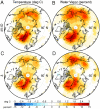Changes in Arctic vegetation amplify high-latitude warming through the greenhouse effect
- PMID: 20080628
- PMCID: PMC2803141
- DOI: 10.1073/pnas.0913846107
Changes in Arctic vegetation amplify high-latitude warming through the greenhouse effect
Abstract
Arctic climate is projected to change dramatically in the next 100 years and increases in temperature will likely lead to changes in the distribution and makeup of the Arctic biosphere. A largely deciduous ecosystem has been suggested as a possible landscape for future Arctic vegetation and is seen in paleo-records of warm times in the past. Here we use a global climate model with an interactive terrestrial biosphere to investigate the effects of adding deciduous trees on bare ground at high northern latitudes. We find that the top-of-atmosphere radiative imbalance from enhanced transpiration (associated with the expanded forest cover) is up to 1.5 times larger than the forcing due to albedo change from the forest. Furthermore, the greenhouse warming by additional water vapor melts sea-ice and triggers a positive feedback through changes in ocean albedo and evaporation. Land surface albedo change is considered to be the dominant mechanism by which trees directly modify climate at high-latitudes, but our findings suggest an additional mechanism through transpiration of water vapor and feedbacks from the ocean and sea-ice.
Conflict of interest statement
The authors declare no conflict of interest.
Figures





References
-
- Lloyd A. Ecological histories from Alaskan tree lines provide insight into future change. Ecology. 2005;86:1687–1695.
-
- Bonan GB. Forests and climate change: Forcings, feedbacks, and the climate benefits of forests. Science. 2008;320:1444–1449. - PubMed
-
- Fischlin A, et al. In: Climate Change 2007: Impacts, Adaptation and Vulnerability. Contributionof Working Group II to the Fourth Assessment Report of the Intergovernmental Panel on Climate Change. Parry ML, et al., editors. Cambridge UK and New York: Cambridge Univ. Press; 2007. pp. 211–272.
-
- Edwards M, Brubaker L, Lozhkin A, Anderson P. Structurally novel biomes: A response to past warming in Beringia. Ecology. 2005;86:1696–1703.
-
- Liu H, Randerson J, Lindfors J, Chapin F. Changes in the surface energy budget after fire in boreal ecosystems of interior Alaska: An annual perspective. J Geophys Res. 2005;110:D13101.
Publication types
MeSH terms
LinkOut - more resources
Full Text Sources
Other Literature Sources
Miscellaneous

